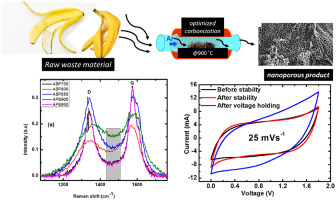Electrochimica Acta ( IF 5.5 ) Pub Date : 2018-01-05 , DOI: 10.1016/j.electacta.2018.01.028 O. Fasakin , J.K. Dangbegnon , D.Y. Momodu , M.J. Madito , K.O. Oyedotun , M.A. Eleruja , N. Manyala

|
Banana peels, a common fruit waste was adopted as a material precursor in this study to synthesize highly porous activated carbon from banana peels (ABP) which serves as an electrode material for a symmetric supercapacitor device. The activation was done using KOH pellets at different carbonization temperatures ranging from 750 °C to 950 °C. The ABP sample obtained from the 900 °C carbonization temperature (ABP900) exhibited unique material properties such as hierarchical porous nano-architecture containing micropores, and mesopores with the highest specific surface area (1362 m2 g−1). Electrochemical performance investigation in different neutral aqueous electrolytes showed that the best response was obtained in NaNO3 for the ABP900 electrode. The symmetric device subsequently assembled using 1 M NaNO3 operated in a potential window of 1.8 V, exhibited a specific capacitance of 165 F g−1 with a corresponding energy density of 18.6 W h kg−1 at 0.5 A g−1. A 100% capacitance retention and columbic efficiency were obtained after 10000 continuous charge-discharge cycles at 5 A g−1. Remarkably, after subjecting the symmetric device to a voltage holding test for 60 h, the specific capacitance was observed to increase from 165 F g−1 to 328 F g−1 with a corresponding increased energy density to about 36.9 W h kg−1 at 0.5 A g−1, suggesting a 98% increase in device energy density from its initial value after voltage holding. Thus, the results reported showcase the ABP900 material as a potential nanostructured porous material useful in the design of high-performance electrodes for stable electrochemical capacitors.
中文翻译:

具有活性的香蕉皮的多孔碳的合成和表征,具有多孔性,可改善电化学性能
香蕉皮,一种常见的水果废料,被用作本研究的材料前体,是从香蕉皮(ABP)合成高度多孔的活性炭,而香蕉皮用作对称超级电容器装置的电极材料。使用KOH颗粒在750°C至950°C的不同碳化温度下进行活化。从900°C的碳化温度(ABP900)获得的ABP样品表现出独特的材料特性,例如包含微孔的分层多孔纳米结构以及具有最高比表面积(1362 m 2 g -1)的中孔。在不同中性水性电解质中的电化学性能研究表明,在NaNO 3中获得了最佳响应用于ABP900电极。对称设备随后使用1M的NaNO组装3在1.8 V的电位窗口操作时,表现出165 F G的特定电容-1与18.6 W时千克的相应的能量密度-1 0.5 A G -1。在5 A g -1下进行10000次连续充放电循环后,可获得100%的电容保持率和库仑效率。值得注意的是,在对对称器件进行了60 h的电压保持测试后,观察到比电容从165 F g -1增加到328 F g -1,同时能量密度相应增加到36.9 W h kg -1。 0.5 A g -1,表明器件的能量密度从保持电压后的初始值增加了98%。因此,报道的结果展示了ABP900材料是一种潜在的纳米结构多孔材料,可用于设计稳定电化学电容器的高性能电极。











































 京公网安备 11010802027423号
京公网安备 11010802027423号